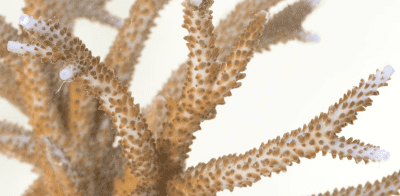Home › Sites › Asia › Cambodia › Sihanoukville › Koh Tang › Explosion Reef
Scuba Diving at Explosion Reef Koh Tang
Are you planning a dive at Koh Tang? If so, there's a reef that explodes with vibrant colours of juvenile fish species swimming against a backdrop of staghorn coral.
The information in this section explains how to get to Explosion Reef dive site, average depth limits, and what kind of marine species you should see below the surface.
Best Month for Diving at the Explosion Reef
One reason visitors scuba dive the islands at Sihanoukville is for warm sea temperatures of 26 to 30° Celsius (78-86 Fahrenheit).
This area of South East Asia usually gets the wet season from June to October and the dry season starts in November until May.
Even so, most scuba schools in Cambodia offer year round scuba diving and snorkeling lessons at the nearby islands.
Sihanoukville city is one of the popular destinations that backpackers and tourists choose when visiting the area.
There are twenty two (22) islands in the province of Sihanoukville, and a few of them have private ownership. Even so, many of the favoured diving locations have not yet been destroyed by any significant foreign investment.
The stunning scenery at Koh Tang Island creates an ideal escape from the noise and pollution of life in the city. So, visitors will make the short journey from the coastal city of Sihanoukville and enjoy a relaxing day trip around the sundrenched archipelago.
This area is a paradise for scuba divers and there are many dive spots to choose from. In general, you should base the destination on which particular sea life creatures you are hoping to encounter.
Note: Explosion Reef dive spot is shallow in some areas with maximum depths around eighteen (18) metres. So, some dive schools will conduct the PADI® Open Water Diver course at this quiet location to the south of Koh Tang Island.
Marine Life Found at Explosion Reef
You will find this popular offshore reef nestled in a small channel at the south of the island. Its name does not refer to dynamite fishing, or anything else untoward. Instead, it describes the colourful barrage of tropical fish displaying a mass of dazzling pigmentation.
The shallow part of the reef settles on the seabed around six (6) metres. Then, as you swim further along you can eventually get down to eighteen (18) metres.
Most of the year, divers will experience good visibility, sometimes in the thirty metre range. Even so, you should be getting twenty metres of clear water around you as an average.
Fields of Staghorn Coral
The gardens of hard coral are mostly species of pale brown staghorn coral. Another section explains how big can staghorn coral get (Acropora muricata) - the answer may surprise you.
The field of shrub-like branches creates a safe shelter for reef fishes to feed and breed. Large plate coral species (sometimes called mushroom coral), along with a scattering of bommies, provide additional shelter for the bigger specimens.
You should see different coloured crinoids (echinoderms) and Christmas tree worms smothering the coral bommie formations. Other common species you should encounter in the area include anthias, damsels, and:
 Blennies fish
Blennies fish- Dottybacks (Pseudochromidae)
- Lionfish
- Moray eels
- Parrotfishes
- Porcupine fish
- Puffer fish (Tetraodontidae)
- Spotted sweetlips
- Trumpet fish
The coral bommies (found at twelve metres) create safe shelters for many of the smaller marine species. But, look around in the sandy areas and you might see blue-spotted stingrays and large groupers.
Note: This is a great diving location for small colourful reef fishes. But, take care of your fins and wetsuit because the notoriously aggressive titan triggerfish may prowl the reefs in this area.
Related Information and Help Guides
There is no shortage of dive sites for divers of all certification levels to explore when scuba diving Koh Tang Island, Sihanoukville. Some of the best spots for qualified divers include:
Note: Another section explains more about interacting passively with marine animals and the importance of dive safety around hazardous sea life.